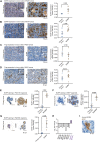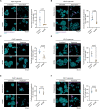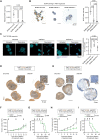BCRP drives intrinsic chemoresistance in chemotherapy-naïve breast cancer brain metastasis
- PMID: 37851804
- PMCID: PMC10584345
- DOI: 10.1126/sciadv.abp9530
BCRP drives intrinsic chemoresistance in chemotherapy-naïve breast cancer brain metastasis
Abstract
Although initially successful, treatments with chemotherapy often fail because of the recurrence of chemoresistant metastases. Since these tumors develop after treatment, resistance is generally thought to occur in response to chemotherapy. However, alternative mechanisms of intrinsic chemoresistance in the chemotherapy-naïve setting may exist but remain poorly understood. Here, we study drug-naïve murine breast cancer brain metastases (BCBMs) to identify how cancer cells growing in a secondary site can acquire intrinsic chemoresistance without cytotoxic agent exposure. We demonstrate that drug-naïve murine breast cancer cells that form cancer lesions in the brain undergo vascular mimicry and concomitantly express the adenosine 5'-triphosphate-binding cassette transporter breast cancer resistance protein (BCRP), a common marker of brain endothelial cells. We reveal that expression of BCRP by the BCBM tumor cells protects them against doxorubicin and topotecan. We conclude that BCRP overexpression can cause intrinsic chemoresistance in cancer cells growing in metastatic sites without prior chemotherapy exposure.
Figures







Similar articles
-
Multidrug resistance mediated by the breast cancer resistance protein BCRP (ABCG2).Oncogene. 2003 Oct 20;22(47):7340-58. doi: 10.1038/sj.onc.1206938. Oncogene. 2003. PMID: 14576842 Review.
-
Role of breast cancer resistance protein in the bioavailability and fetal penetration of topotecan.J Natl Cancer Inst. 2000 Oct 18;92(20):1651-6. doi: 10.1093/jnci/92.20.1651. J Natl Cancer Inst. 2000. PMID: 11036110
-
Role of ABC-cassette transporters (MDR1, MRP1, BCRP) in the development of primary and acquired multiple drug resistance in patients with early and metastatic breast cancer.Exp Oncol. 2013 Dec;35(4):287-90. Exp Oncol. 2013. PMID: 24382439
-
Neoadjuvant Endocrine Therapy in Breast Cancer Upregulates the Cytotoxic Drug Pump ABCG2/BCRP, and May Lead to Resistance to Subsequent Chemotherapy.Clin Breast Cancer. 2018 Dec;18(6):481-488. doi: 10.1016/j.clbc.2018.07.002. Epub 2018 Jul 6. Clin Breast Cancer. 2018. PMID: 30055962
-
Functions of the breast cancer resistance protein (BCRP/ABCG2) in chemotherapy.Adv Drug Deliv Rev. 2009 Jan 31;61(1):26-33. doi: 10.1016/j.addr.2008.07.003. Epub 2008 Dec 3. Adv Drug Deliv Rev. 2009. PMID: 19111841 Review.
Cited by
-
CD2-CD58 axis orchestrates cytotoxic T lymphocyte function and metabolic crosstalk in breast cancer brain metastasis.J Cell Commun Signal. 2025 Aug 24;19(3):e70040. doi: 10.1002/ccs3.70040. eCollection 2025 Sep. J Cell Commun Signal. 2025. PMID: 40859981 Free PMC article.
-
Molecular mechanisms and therapeutic strategies in overcoming chemotherapy resistance in cancer.Mol Biomed. 2025 Jan 6;6(1):2. doi: 10.1186/s43556-024-00239-2. Mol Biomed. 2025. PMID: 39757310 Free PMC article. Review.
-
Drug Treatment Direction Based on the Molecular Mechanism of Breast Cancer Brain Metastasis.Pharmaceuticals (Basel). 2025 Feb 16;18(2):262. doi: 10.3390/ph18020262. Pharmaceuticals (Basel). 2025. PMID: 40006075 Free PMC article. Review.
-
Translational Advances in Oncogene and Tumor-Suppressor Gene Research.Cancers (Basel). 2025 Mar 17;17(6):1008. doi: 10.3390/cancers17061008. Cancers (Basel). 2025. PMID: 40149342 Free PMC article. Review.
-
Biological profile of breast cancer brain metastasis.Acta Neuropathol Commun. 2025 Apr 19;13(1):78. doi: 10.1186/s40478-025-01983-4. Acta Neuropathol Commun. 2025. PMID: 40253355 Free PMC article. Review.
References
-
- A. Boire, P. K. Brastianos, L. Garzia, M. Valiente, Brain metastasis. Nat. Rev. Cancer 20, 4–11 (2020). - PubMed
-
- N. J. Abbott, A. A. Patabendige, D. E. Dolman, S. R. Yusof, D. J. Begley, Structure and function of the blood-brain barrier. Neurobiol. Dis. 37, 13–25 (2010). - PubMed
-
- A. H. Schinkel, J. J. Smit, O. van Tellingen, J. H. Beijnen, E. Wagenaar, L. van Deemter, C. A. Mol, M. A. van der Valk, E. C. Robanus-Maandag, H. P. te Riele, A. J. M. Berns, P. Borst, Disruption of the mouse mdr1a P-glycoprotein gene leads to a deficiency in the blood-brain barrier and to increased sensitivity to drugs. Cell 77, 491–502 (1994). - PubMed
-
- A. H. Schinkel, P-glycoprotein, a gatekeeper in the blood-brain barrier. Adv. Drug Deliv. Rev. 36, 179–194 (1999). - PubMed
MeSH terms
Substances
LinkOut - more resources
Full Text Sources
Medical
Molecular Biology Databases

